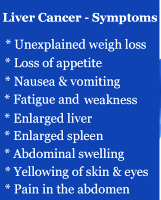Liver Cancer or Hepatic Cancer arises from the liver cells. It is of two types (a) Hepatocellular carcinoma or HCC 80% (b) Intrahepatic cholangiocarcinoma 20%
Liver Cancer Causes
In 80% of patients liver cancer develop under the background of chronic liver disease. Most common cause are alcohol intake, Hepatitis B & C infection.
Fatty liver due to obesity, diabetes and hyperlipidemia is emerging as the main cause of liver cancer in future
There are certain inherited liver diseases such as hemochromatosis and wilsons disease which increase the risk
Exposure to aflatoxins, poisons produced by molds can also cause liver cancer
Symptoms
 Pain right upper abdomen
Pain right upper abdomen
Anorexia & weight loss
Patients with chronic liver disease when develop liver tumor may have wosen there symptoms such as ascites, jaundice
Diagnosis
USG abdomen: First investigation done for any abdomen complaint. It will show a space occupying lesion in the liver, echotexture of liver, biliary tract dilatation, any associated abdominal lymphadenpathy, ascites.
Triple phase CT abdomen: More specific for liver lesions
Alfa-feto protein: Tumor marker specific for liver tumor.
FNAC: It is advised for liver lesions in which imaging study is inconclusive
Treatment
Liver Cancer Treatment depends whether liver cancer develops under the background of nomal or diseased liver. Chronic liver disease patients have a very high recurrence rate after liver resection and liver transplant is preferred in these patients if donor is available. Various local ablative procedures are available if patient is not fit for surgery or as palliative treatment for advance cancer
Liver Resection
It is first line of treatment if cancer occur in normal liver and after resection adequate amount of liver volume can be saved for normal liver function. It is said that about 30% of normal liver volume should be left after resection for adequate liver function
Liver Transplant
Transplant is preferred in CLD patients, if fulfills the criteria for transplant and donor is available. If there is long waiting list for donor meanwhile liver resection or local ablative procedure can be done
Milan criteria for liver transplant in liver cancer patients is associated with 70% 5 year survival rate. These criteria include a single tumor wth size 5 cm or less, maximum three tumors with size 3 cm or less and without evidence of vascular invasion. If tranplant is done beyond these criteria long term survival rate may not be good
Local Ablative Procedures
Ablation means tissue destruction without removing them. This technique is used in liver cancer when there are few small tumors and surgery is not a good option because of poor liver function/ poor health status of patient/ long waiting list for liver transplant. Various ablative procedures available are Radiofrequency ablation (RFA), Microwave ablation (MWA), Cryoablation (Cryotherapy), Ethanol (Alcohol) ablation
Prognosis
It depends on many factors such as tumor size, no of primary lesions, loco-regional or distant spread, Underlying liver disease and general health status of the patient
Survival Rate
Most important factor that decide survival rate is staging. Generally distant metastases cancer has worst prognosis with life span of 6 months with best available treatment, Locally advanced tumor patients survive up to 2 year with best treatment. For localized tumor in cirrhotic patients Liver transplant when done under strict criteria has got very good prognosis with 5 year survival rate of 75%

